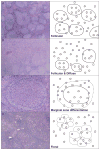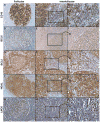Immunoarchitectural patterns in follicular lymphoma: efficacy of HGAL and LMO2 in the detection of the interfollicular and diffuse components
- PMID: 20697248
- PMCID: PMC2929284
- DOI: 10.1097/PAS.0b013e3181e9343d
Immunoarchitectural patterns in follicular lymphoma: efficacy of HGAL and LMO2 in the detection of the interfollicular and diffuse components
Abstract
Follicular lymphoma (FL) can exhibit variant histologic patterns that can lead to confusion with other B-cell lymphomas and reactive conditions. Diagnostic markers such as CD10 and BCL2 may be difficult to interpret in variant FL patterns, and are often diminished or absent in the interfollicular and diffuse components. We evaluated 2 recently characterized germinal center B-cell markers, human germinal center associated lymphoma (HGAL), and LIM-only transcription factor 2 (LMO2), in 127 FL patient biopsies (94 nodal, 33 extranodal), and correlated the findings with histologic pattern, cellular composition, grade, and additional immunostains (CD20, CD3, CD21, CD10, BCL2, and BCL6). Architectural patterns included predominantly follicular (75%) and follicular and diffuse components (25%); 10 cases showed marginal zone differentiation and 3 were floral variants. Eighty-nine cases were low grade (38 grade 1; 51 grade 2) and 38 were grade 3 (29 grade 3A and 9 grade 3B). HGAL had the highest overall sensitivity of detecting FL and was superior in detecting the interfollicular and diffuse components compared with BCL2, LMO2, CD10, and BCL6. All 28 cases that lacked CD10, expressed HGAL, and the majority also expressed LMO2. Our results show that HGAL and LMO2 are sensitive markers for FL diagnosis. The addition of HGAL and LMO2 to the immunohistologic panel is beneficial in the work-up of nodal and extranodal B-cell lymphomas and the efficacy of HGAL in detecting the follicular, interfollicular and diffuse components of FL is of particular value in the setting of variant immunoarchitectural patterns.
Figures





Similar articles
-
The efficacy of HGAL and LMO2 in the separation of lymphomas derived from small B cells in nodal and extranodal sites, including the bone marrow.Am J Clin Pathol. 2011 May;135(5):697-708. doi: 10.1309/AJCP7Z2BIBUNQPLZ. Am J Clin Pathol. 2011. PMID: 21502424 Free PMC article.
-
[Expression and significance of HGAL and LMO2 in follicular lymphoma].Zhonghua Bing Li Xue Za Zhi. 2016 Feb;45(2):83-5. doi: 10.3760/cma.j.issn.0529-5807.2016.02.003. Zhonghua Bing Li Xue Za Zhi. 2016. PMID: 26879427 Chinese.
-
Comparison of Myocyte Enhancer Factor 2B Versus Other Germinal Center-associated Antigens in the Differential Diagnosis of B-Cell Non-Hodgkin Lymphomas.Am J Surg Pathol. 2018 Mar;42(3):342-350. doi: 10.1097/PAS.0000000000001015. Am J Surg Pathol. 2018. PMID: 29309299
-
The life and death of the germinal center.Ann Diagn Pathol. 2020 Feb;44:151421. doi: 10.1016/j.anndiagpath.2019.151421. Epub 2019 Nov 13. Ann Diagn Pathol. 2020. PMID: 31751845 Review.
-
LMO2 and BCL6 are associated with improved survival in primary central nervous system lymphoma.Br J Haematol. 2014 Jun;165(5):640-8. doi: 10.1111/bjh.12801. Epub 2014 Feb 26. Br J Haematol. 2014. PMID: 24571259 Free PMC article. Review.
Cited by
-
Divergent immunohistochemical expression of CD21 and CD23 by follicular dendritic cells with increasing grade of follicular lymphoma.World J Surg Oncol. 2019 Jul 3;17(1):115. doi: 10.1186/s12957-019-1659-8. World J Surg Oncol. 2019. PMID: 31269981 Free PMC article.
-
Indolent T-cell-rich small B-cell hepatic lymphoma in a Golden Retriever.Clin Case Rep. 2018 Jun 6;6(8):1436-1444. doi: 10.1002/ccr3.1580. eCollection 2018 Aug. Clin Case Rep. 2018. PMID: 30147878 Free PMC article.
-
Pattern of MEF2B expression in lymphoid tissues and in malignant lymphomas.Virchows Arch. 2015 Sep;467(3):345-55. doi: 10.1007/s00428-015-1796-6. Epub 2015 Jun 19. Virchows Arch. 2015. PMID: 26089142
-
Low-Grade Primary Splenic CD10-Positive Small B-Cell Lymphoma/Follicular Lymphoma.Curr Oncol. 2021 Nov 18;28(6):4821-4831. doi: 10.3390/curroncol28060407. Curr Oncol. 2021. PMID: 34898578 Free PMC article. Review.
-
The efficacy of HGAL and LMO2 in the separation of lymphomas derived from small B cells in nodal and extranodal sites, including the bone marrow.Am J Clin Pathol. 2011 May;135(5):697-708. doi: 10.1309/AJCP7Z2BIBUNQPLZ. Am J Clin Pathol. 2011. PMID: 21502424 Free PMC article.
References
-
- Anderson JR, Armitage JO, Weisenburger DD. Epidemiology of the non-Hodgkin's lymphomas: distributions of the major subtypes differ by geographic locations. Non-Hodgkin's Lymphoma Classification Project. Ann Oncol. 1998;9:717–720. - PubMed
-
- Bacon CM, Ye H, Diss TC, et al. Primary follicular lymphoma of the testis and epididymis in adults. Am J Surg Pathol. 2007;31:1050–1058. - PubMed
-
- Bosga-Bouwer AG, van den Berg A, Haralambieva E, et al. Molecular, cytogenetic, and immunophenotypic characterization of follicular lymphoma grade 3B; a separate entity or part of the spectrum of diffuse large B-cell lymphoma or follicular lymphoma? Hum Pathol. 2006;37:528–533. - PubMed
-
- Cattoretti G, Chang CC, Cechova K, et al. BCL-6 protein is expressed in germinal-center B cells. Blood. 1995;86:45–53. - PubMed
-
- Damaj G, Verkarre V, Delmer A, et al. Primary follicular lymphoma of the gastrointestinal tract: a study of 25 cases and a literature review. Ann Oncol. 2003;14:623–629. - PubMed
Publication types
MeSH terms
Substances
Grants and funding
LinkOut - more resources
Full Text Sources

